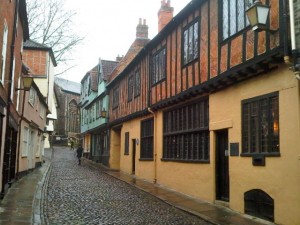Norwich is one of our finest medieval cities, with a pluperfect cathedral, a Norman castle, a maze of historic shopping streets of distinction and miles of riverside walks. Now it’s been named the first English UNESCO City of Literature. Yet many of us miss this hidden gem, out there in East Anglia.
There is something in the spirit of Norwich that reminds me of the old cities and towns of Belgium, France and Germany. It has more medieval churches – 32 – than anywhere north of the Alps. And the largest intact medieval street pattern in Europe.
This compact city’s character is spread around steep little alleyways and old cobbled streets. The best, between Market Place and the Wensum River, are marketed as the Norwich Lanes. If you only have time for one, make it the distinguished, cobbled Elm Hill, with its half-timbered Tudor houses and antique shops.
Then dive into the art nouveau Royal Arcade. There is a big retail centre but the planners hid it inside Castle Hill. Norwich easily passes my “well worth a weekend away” test. It’s a comfortable drive from the M1 and M25, mostly dual carriageway. Trains arrive from all over at the grand old railway station. Entertainment includes Cinema City, one of the UK’s oldest art house cinemas, the venerable Theatre Royal and the Shakespeare festival held in July in the cathedral cloisters.
The prime attractions are gathered under the “Norwich 12” slogan. We zig-zagged between some of the UK’s finest buildings from the Norman, Medieval, Georgian, Victorian and modern eras, from the restored 16C Dragon Hall, via the Georgian Assembly House, to the C21st Forum, which houses the fabulous Norfolk & Norwich Millennium Library.
Norwich can boast Britain’s most complete Norman Cathedral (dedicated in 1145), with the second tallest spire (315ft – only Salisbury’s is higher) and the largest surviving cloister in England. It stands serene and apart, in its own wide green space, behind ancient arches.
There are many venerable details – decorative roof bosses, powerful drum-shaped pillars and stained-glass windows – but perhaps the most eye-catching is the shiny copper vat in the middle of the nave. This is the Rowntree Font, once used in the company’s Chocolate Factory. It was a subliminal prompt to coffee and cakes in the excellent refectory. In deeply historic Magdalen Street, a five-minute walk from the mazy old city centre streets, we found Gothic House, an upmarket two bedroom B&B.
Clive Harvey did up this derilict grade II-listed Regency house and crammed it with tasteful old things, every one of them a conversation-opener. As well as Clive’s chat, there was his affectionate black cat Khmer keeping us company at breakfast. Norwich offers lively dining in interesting old buildings.
The Library Restaurant Bar and Grill is in a pioneer Victorian subscription library. (Appropriate as this is the first English city to be awarded the UNESCO City of Literature accolade, one of only six in the world, in recognition of Norwich’s literary past.) The tables are set under soaring glass ceilings, surrounded by original oak bookcases and books. They offer a brasserie-style menu, cooking on a wood-fired grill.
We also liked The Graze, a restaurant above the Mad Moose pub (2 Warwick Street), where a range of tastes come in small portions (around £6 each). Like tapas, only bigger. (Norwich, since my visit, has a fabulous new museum, The Bridewell, which tells the story of Norwich and its people. And there is punting on the river Wensum.
In a long weekend, there’s time to explore Norfolk by car or bus. The Broads are an easy trip to the east. We chose the North Norfolk coast, an hour, or 30 miles, away. Our table at the White Horse in Brancaster Staithe looked over the salt-marshes, misty and mysterious on a winter afternoon.
We walked the Norfolk Coast Path west for a mile or so, on a stout new boardwalk. First stop was the National Trust-owned site of the Roman fort of Branodunum, its secrets safely buried under a wide field. Then out onto Brancaster beach to see the evening fly-pass by the Brent geese, in fine formation over the wide sands. Gareth stayed at the Gothic House Further information www.visitnorwich.co.uk Here’s a link to my Mail on Sunday piece on Norwich.

